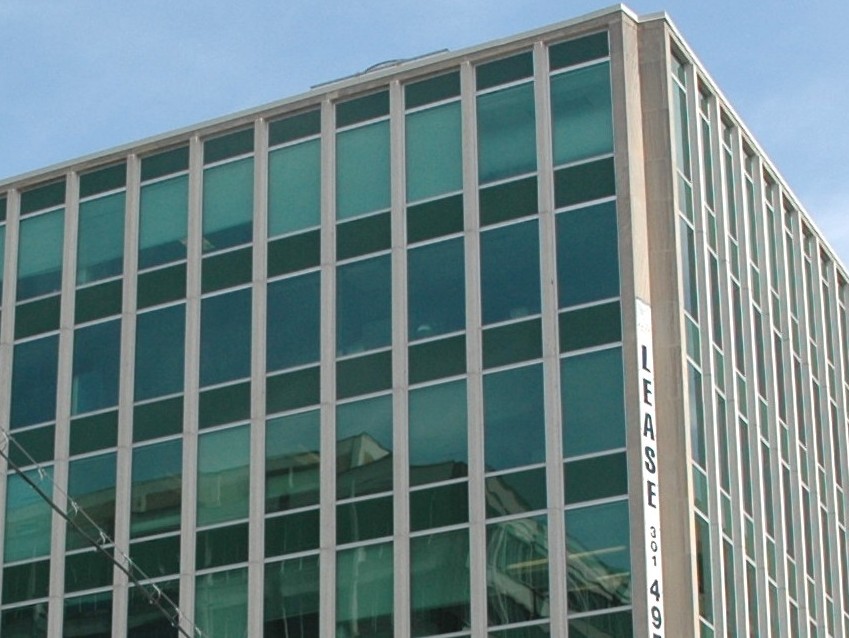This article has been corrected with two facts: the exterior panels are glass, not porcelain, and in the summer of 2012, the horizontal band over the parking lot entrance was taken down for construction of 8711 Georgia Avenue. Thanks to readers for your comments. Clare Lise Kelly 9-12-12
Designed by architect Edwin Weihe in 1960, the American National Bank Building, at 8701 Georgia Avenue, is a fine example of an International style office building. When it opened in 1961, it was the tallest building in Silver Spring and featured several design innovations.

Architect Edwin Weihe placed the building’s heating, cooling, and elevator equipment in a low roof penthouse, designed so that it is not immediately apparent from the streetview. Real estate columnist Joseph Byrne, of the Washington Star, observed that Weihe’s design followed advice of the Washington Fine Arts Commission to avoid ugly penthouses prominent in Washington’s skyline by 1961.
The structure has precast quartz mullions that are welded to the steel frame. Each mullion is 6 inches wide, 8 inches deep and 10 feet tall, and weighes 800 pounds. Two metal plates are embedded into the cast mullions and welded to metal plates sunk into the concrete superstructure.

A historic view of this building shows how little it has changed. One element that has been lost is the horizontal band at the street level that connects the parking lot entrance to the main building. This element was taken down in July 2012 for the construction of 9711 Georgia Avenue.
The modernist building with green glass panels certainly bear witness to the influence of such a landmark as Gordon Bunshaft’s Lever House which dates from 1952. Lever House, Park Avenue, New York City, was a harbinger of the glass curtain wall technology that predominated mid-century commercial buildings. Note the horizontal section next to the tower, and the Le Corbusier style pilotis, both echoed in the American National Bank building.
Architect Edwin Armstrong Weihe (1907-1994) had a major influence on the development of downtown Washington. Known as “Mr. Zoning” for his active role in modernizing city codes, he pioneered the innovative use of concrete in Washington, DC, and was known for his use of pedestrian arcades and graduated setbacks.
Specializing in office buildings, hotels, apartment buildings, mixed use buildings and other commercial structures, Weihe’s firm designed more than 90 office buildings in the K Street corridor and elsewhere in the District, and more than 100 large buildings in Crystal City, Bailey’s Crossroads, and other urban centers. In Montgomery County, Weihe designed several other mid-century projects in the Silver Spring area including a store and apartment at 7614 Georgia Avenue NW (1940); Rock Creek Gardens apartments (1948), near Grubb Road and East West Highway; and Cape Cod houses for Carroll Knolls subdivision of 200 dwellings (1948), Forest Glen; and the F. W. Woolworth & Co. store (1954), Flower Avenue Shopping Center.
A member of the AIA from 1946, Edwin Weihe received the first lifetime achievement award ever bestowed by the Washington Chapter of the AIA, when he was presented with the Centennial Award in 1991. He was recognized for being the first architect to promote flat plate concrete construction as a solution to the city’s building height restriction, as well as for his pioneering the use of precast concrete as building cladding in the District. Edwin Weihe retired from active practice in 1987. He died in 1994, at the age of 87.
In the design phase, the Silver Spring office building was originally called the Bank of Silver Spring but by the time it opened it was renamed the American National Bank, which company occupied the first and lower levels. It is now known as the Zalco Building.

MontgomeryModern explores mid-century modern buildings and communities that reflect the optimistic spirit of the post-war era in Montgomery County, Maryland. From International Style office towers to Googie style stores and contemporary tract houses, MontgomeryModern celebrates the buildings, technology, and materials of the Atomic Age, from the late 1940s through the 1960s. A half century later, we now have perspective to appreciate these resources as a product of their time.
gk
This is a wonderful building. One of the things that separates the great from the average in Modern Architecture is an elegance and sophistication in detailing that other styles can circumvent with enough applied “makeup.” The example you cite, Lever House, stands apart from all its glass sheathed neighbors (save one) for that reason. That one is the Seagram Building, which if Modern Architecture has a Parthenon, this is it.
Look at American National the same way, standing against lesser office buildings is SIlver Spring or K Street. The proportion of the spandrel panels to the vision glass, the sturdiness of the vertical mullions to the slenderness of the horizontal mullions, and the vacated corner (a bit like Seagram) are details that set this building apart.
Thanks for bringing it to our attention.
Clare Lise Kelly
Good point. Also, I like the way that the facade has the appearance of being solid as one approaches the building from a distance on Georgia Avenue, because the mullions have such depth. Then as one gets closer, the spaces between the mullions expand to reveal the grid of brilliant green glass.